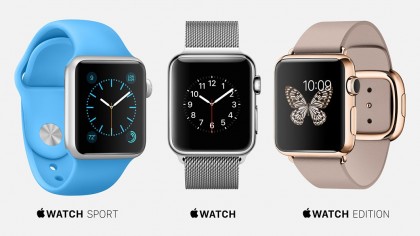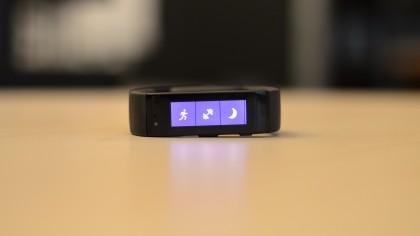Apple Watch vs Microsoft Band

Apple Watch vs Microsoft Band
The Microsoft Band isn't the best fitness tracker out there but it's definitely one of the most popular despite being an elusive unicorn in store and online.
The Band's unique features are also why pitting it against the upcoming Apple Watch make sense despite the former being a fitness tracker and the latter a smartwatch.
You may also be wondering which wearable to get. This versus will hopefully help you avoid a wristy situation where you end up choosing a tracker or watch unsuited to your needs.

Design: Microsoft Band
The Microsoft Band isn't the most ergonomic device or visually appealing. The Band's jampacked with ten sensors which probably made designing something fashionable difficult.
Most of the time, it's barely recognizable - when I wear it out, people typically don't catch on that it's a Microsoft Band until I tell them.
So far, the band only comes in black and isn't interchangeable though you can get in small, medium or large. It's made of a thermal plastic elastomer material and is pretty comfy against the skin.

Design: Apple Watch
The Apple Watch on the other hand, is as fashionable as you can get.
From different band materials to colors and cases, there are a lot of options - 38 Apple Watch designs to be exact. Then there are the eight rather ostentatious, high end 18-karat gold Apple smartwatches.
If gold and Sapphire crystal glass sound too expensive for you, the Sports edition should do the trick - its made of aluminum and Ion-X glass and comes with a smooth fluoroelastomer band supposedly making it resilient for all activities.

Display: Microsoft Band
The Microsoft Band is one of the few fitness trackers out there with a decent screen. For the outdoorsy types, it won't be difficult to see your notifications on the 1.4-inch TFT (320 x 106 pixels) full color display in the harsh sunlight. The ambient light sensor is a nice addition too.

Display: Apple Watch
The Apple Watch has two case sizes: 38mm and 42mm in height. Both have AMOLED Retina displays with high pixel densities.
There's also a single layer of scratch-resistant sapphire glass, at least among its higher-priced editions, and ION-X on the lower-priced pieces.

Software: Microsoft Band
There's no fancy operating system on the Microsoft Band. Rather it's a simple, platform-agnostic operating system. Interestingly, Microsoft decided to use a wearable architecture that has been optimized for low-power micro-devices, instead of Windows 10 or a modified version of Windows.
You can change the colors and design of the home screen from a pre-determined list in your Microsoft Health app but that's as far as visual customizations go. Apps themselves can be switched around but you can only have 13 apps on the device.
There also aren't too many apps on the Band, but Microsoft says it will continue to keep adding more over time.

Software: Apple Watch
With the release of iOS 8.2, came an Apple Watch app - bloatware to be specific, because you can't delete it even if you don't have an Apple wearable.
The Apple apps ecosystem seems pretty rich already considering iOS is heavily developed for. Expect a lot of "glanceable" type apps and notifications with the iWatch when it comes out as well.
There are also a bunch of watch faces pre-installed and likely more on the way.

Waterproof: Apple Watch vs Microsoft Band
A major drawback for a fitness tracker? Lack of water resistance abilities which is an issue with the Microsoft Band. It's supposed to be "splash resistant" which basically means you can wipe it down with a damp cloth.
According to Tim Cook, the Apple Watch is water resistant. The Apple Watch waterproof rating has been certified at IPX7, which means that it can be immersed in water up to 1 meter for up to 30 minutes.

Fitness: Microsoft Band
A fitness tracker focusing on fitness, what a concept! Except the Microsoft Band takes the idea and really runs with it (punny). Again, there are ten sensors - an optical heart rate sensor, 3-axis accelerometer, gyrometer, GPS, ambient light sensor, skin temperature sensor, UV sensor, capacitive sensor, microphone and a galvanic skin response sensor - where most of them have to do with fitness.
The Health platform is also part of the device's fitness experience though it's not exactly up to speed yet. However, Microsoft does say it needs to collect a lot of data from a lot of people, which its still in the process of meaning there will be many more updates along the way.

Fitness: Apple Watch
Unlike the Band, the Apple Watch has no GPS and doesn't have as many sensors. However, it isn't completely empty handed in the fitness department.
There will be three activity tracking metrics the Watch will employ: Move shows how many calories you've burned while wearing the watch. Exercise keeps track of your most active minutes and Stand measures how long you spend on your feet.
An app called Workout will also provide real-time stats for your total exercise time, distance, calories and pace.
Like Microsoft, Apple intends to keep you motivated with goals, reminders and achievements - though also like Microsoft, seeing these features in action might be a different story.

Battery life: Microsoft Band
The battery life of a wearable is typically a sore subject as they only last one to two days at best - unless it's a Pebble device which last seven to ten days.
Microsoft hits the average of two days with its fitness tracker. That's also dependent on usage but results have been satisfactory with my time with the band.

Battery life: Apple Watch
The Apple Watch's battery life doesn't sound too promising. Apparently, you'll need to charge this device every day. Again it depends on your usage but 18 hours seems like the average the Apple Watch can stay alive.

Compatibility: Microsoft Band
Most fitness trackers are cross-platform, but there are still a few out there that aren't. The Microsoft Band is in the mostly compatible camp as it works with iOS 7.1, iOS 8, Windows Phones 8.1 and Android 4.3-4.4 devices through Bluetooth.
If you're using a Windows Phone, Cortana is another handy option the Band offers. Through a data or Wi-Fi connection, you can use voice commands to set alarms, dictate short voice notes, create time/location/people based reminders, ask Bing questions, create calendar events, play music through your phone, and tell it to call or text message people.

Compatibility: Apple Watch
Despite early rumors that the iWatch would be Android-friendly, it's not. True to Apple fashion, the timepiece will work solely with iOS mobile devices, and only iPhone 5 or later on iOS 8.2 to boot.
Like Cortana on the Band, Siri will play a huge role with the Apple Watch.

Price: Microsoft Band
For a fitness tracker, the Microsoft Band is on the pricier side at $199 (about £125, AU$230).
It costs more than a $150 (£125, AU$180) Jawbone UP24 but less than a $250 (£200, likely north of AU$290) Fitbit Surge - two other trackers that have been well-received.
But the Band's price still isn't too bad considering you get a color, touchscreen display and ten sensors which have been fairly accurate and helpful.

Price: Apple Watch
The Apple Watch price, on the other hand, starts at $349 (£299), and that's for the 38mm Sport version. At 42mm, it's $399 (£339).
Plus it only goes up from there. The stainless steel regular "Watch" collection starts at $549 (£479) and goes up to $1099 (£949).
The 18-karat gold version tops the price list at $10,000 (£8,000) to $17,000 (£13,500, AU$24,000) with a limited supply in Apple Stores.

Apple Watch vs Microsoft Band Wrap Up
This is a tough choice. Both these wearables are first-gen flagships from their parent companies meaning they're probably not going to be the best just yet.
That said, with consistent updates, the Microsoft Band could be one of the best fitness trackers out there. Unless Microsoft dumps it and makes an even better second-gen device.
The same can be said of the Apple Watch. That battery life could be a killer despite how pretty it is. Oh yeah, that price tag isn't helping either.
Right now, it seems like both the Microsoft Band and Apple Watch have a long way to go. But in some ways, each are carving out a unique path for future iterations of smart wearables to come.